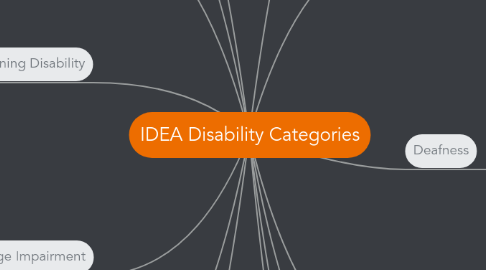
1. Emotional Disturbance
1.1. "a condition exhibiting one or more of the following characteristics over a long period of time and to a marked degree that adversely affects a child’s educational performance: (a) An inability to learn that cannot be explained by intellectual, sensory, or health factors. (b) An inability to build or maintain satisfactory interpersonal relationships with peers and teachers. (c) Inappropriate types of behavior or feelings under normal circumstances. (d) A general pervasive mood of unhappiness or depression. (e) A tendency to develop physical symptoms or fears associated with personal or school problems. The term includes schizophrenia."
1.1.1. Case Study: Megan
2. Orthopedic Impairment
2.1. "a severe orthopedic impairment that adversely affects a child’s educational performance. The term includes impairments caused by a congenital anomaly, impairments caused by disease (e.g., poliomyelitis, bone tuberculosis), and impairments from other causes (e.g.,cerebral palsy, amputations, and fractures or burns that cause contractures)."
3. Other Health Impairment
3.1. "having limited strength, vitality, or alertness, including a heightened alertness to environmental stimuli, that results in limited alertness with respect to the educational environment, that— (a) is due to chronic or acute health problems such as asthma, attention deficit disorder or attention deficit hyperactivity disorder, diabetes, epilepsy, a heart condition, hemophilia, lead poisoning, leukemia, nephritis, rheumatic fever, sickle cell anemia, and Tourette syndrome; and (b) adversely affects a child’s educational performance."
4. Specific Learning Disability
4.1. " a disorder in one or more of the basic psychological processes involved in understanding or in using language, spoken or written, that may manifest itself in the imperfect ability to listen, think, speak, read, write, spell, or to do mathematical calculations. The term includes such conditions as perceptual disabilities, brain injury, minimal brain dysfunction, dyslexia, and developmental aphasia. The term does not include learning problems that are primarily the result of visual, hearing, or motor disabilities; of intellectual disability; of emotional disturbance; or of environmental, cultural, or economic disadvantage."
4.1.1. Teaching Children with Dyslexia
4.1.2. Case Study: Nick
5. Speech or Language Impairment
5.1. "a communication disorder such as stuttering, impaired articulation, a language impairment, or a voice impairment that adversely affects a child’s educational performance."
5.1.1. Speech and Language Thereapy: Helping Michael
6. Traumatic Brain Injury
6.1. "an acquired injury to the brain caused by an external physical force, resulting in total or partial functional disability or psychosocial impairment, or both, that adversely affects a child’s educational performance. The term applies to open or closed head injuries resulting in impairments in one or more areas, such as cognition; language; memory; attention; reasoning; abstract thinking; judgment; problem-solving; sensory, perceptual, and motor abilities; psychosocial behavior; physical functions; information processing; and speech. The term does not apply to brain injuries that are congenital or degenerative, or to brain injuries induced by birth trauma."
7. Visual Impairment Including Blindness
7.1. "an impairment in vision that, even with correction, adversely affects a child’s educational performance. The term includes both partial sight and blindness."
7.1.1. Teaching the Visually Impaired
8. Autism
8.1. "a developmental disability significantly affecting verbal and nonverbal communication and social interaction, generally evident before age three, that adversely affects a child’s educational performance."
8.1.1. Suggested interventions/accomodations: Use special education services employing structured teaching strategies that a) modify the person’s physical environment to optimize their learning; b) use visual schedules and c) teach systematic and organized presentation of tasks/materials in order for students to learn to work independently, without adult directions/prompts.
8.1.2. Suggested assistive technologies: Objects, photographs, realistic drawings, line drawings, and written words, can be used with assorted modes of technology, as long as the child can readily comprehend the visual representation.
8.1.3. Teaching Students with Autism
9. Deaf-blindness
9.1. "concomitant [simultaneous] hearing and visual impairments, the combination of which causes such severe communication and other developmental and educational needs that they cannot be accommodated in special education programs solely for children with deafness or children with blindness."
9.1.1. Suggested interventions/accomodations: a) Special education services; b) teach Braille reading and writing system; c) speech therapy
9.1.2. Suggested assistive technologies: a) Computers with Braille notetakers and translators; b) Braille face-to-face communicators such as Deaf-Blind Communicator (DBC), Braille Sense Plus and Pac Mate; c) voice recognition software and devices; d) text to voice devices and cell phones -GPS systems for the deaf-blind
10. Deafness
10.1. "a hearing impairment so severe that a child is impaired in processing linguistic information through hearing, with or without amplification, that adversely affects a child’s educational performance."
10.1.1. Suggested interventions/accomodations: a) pecial education services; b) teach using American (or appropriate) Sign Language; b) speech therapy
10.1.2. Suggested assistive technologies: -Text telephones (TTY) -Hearing aids
10.1.3. Teaching Music to Deaf Children
11. Developmental Delay
11.1. For children from birth to nine "a delay in one or more of the following areas: physical development; cognitive development; communication; social or emotional development; or adaptive [behavioral] development."
11.1.1. Case Study: Ellie
12. Hearing Impairment
12.1. "an impairment in hearing, whether permanent or fluctuating, that adversely affects a child’s educational performance but is not included under the definition of 'deafness.'”
13. Intellectual Disability
13.1. "significantly subaverage general intellectual functioning, existing concurrently [at the same time] with deficits in adaptive behavior and manifested during the developmental period, that adversely affects a child’s educational performance."
13.1.1. Successful Strategies for Beginning Readers with Down Syndrome
